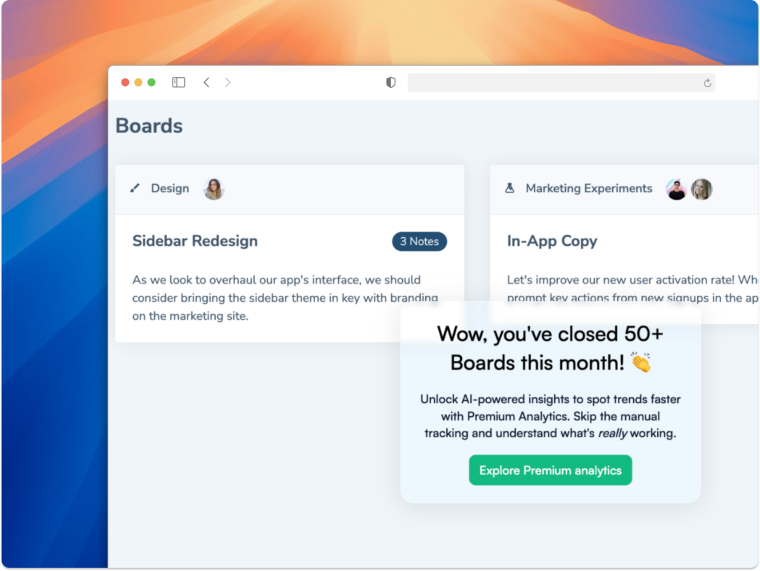In an ever-changing world, and in such a particular sector as SaaS, businesses need to be ahead of the curve, or be early-adopters at the least, to keep their products competitive. This fortune cookie message may seem obvious but proven to be true over and over again. In spite of its wisdom, the question remains: what “ahead of the curve” means for digital products right now?
Even when companies have a product-led growth approach, “product” is not the keyword here—consumers are. In the last decades, the power shift from vendors to users changed the focus from companies’ cool offerings to people’s needs and increasing live expectations. In this scenario, staying ahead of the curve translates into creating an exceptional product experience for them. But, what does product experience actually mean?
What is product experience?
If the product is the vehicle, product experience is the journey. And we can all say for sure, that when we travel what really matters is what we find (and how we feel) along the way. In other words, a product has an intrinsic value that can only turn into real value when it’s perceived as worthy for others. In more theoretical words:
“Product experience is how your consumers perceive your product, based on all the interactions they have with it. PX includes aesthetics, evoked emotions, and experiences of meaning, and is the key that truly differentiates a value proposition.”
As part of the user experience, product experience focuses on the stages of the customer journey that take place within the product itself. From download and first log in, going through onboarding and every feature engagement, until the customer calls it quits, all that happens is an opportunity to improve the relationship between your product and its user base. As you may imagine, a great product experience is aligned with a customer-centric approach to product development as well.
Today more than ever, with business pricing models pivoting towards freemium or free trial options, delivering a memorable product experience is critical. Your customers are able to try your product before making the decision of paying for it and are far from committed to keep using it if something goes under their expectations. If you add a huge pool of competitors fighting to attract them, making them stay requires much more than just a product that works. It requires a product that amazes.

🎥 Webinar: How to launch engaging in-product experiences
Learn how to craft optimal in-product experiences throughout the user journey to increase activation, adoption, and retention.
Who should own product experience?
We have already discussed product management and product development as essential dimensions of a product’s come-to-life. So, it’s no strange to think about these pivotal roles and teams as the owners of the product experience. But, actually, PX requires much more minds and hands than the product team itself, going beyond functionality and UX, beyond engineering and design. Delivering an outstanding product experience is a goal cross-company. Therefore, alignment between the following departments becomes crucial:
Product. The product team cares about the product’s strategy. Product management is the vision’s gatekeeper while engineering and UX take responsibility for building, designing, and optimizing the product’s features to drive adoption and customer retention.
Customer support. The highest source for customer feedback. No team will have more insights from present users than the customer success team, in charge of guiding customers from the first adoption to training and upselling. Here lays the ultimate contact to identify friction points and strengths from the experience the customers have while interacting with the product.
Sales. Another team with great access to customers (and prospects) input. They’ll probably be the first in hearing the accounts’ requests and complaints. They also have a deep understanding of why users move down the funnel and convert into product qualified leads.
Marketing. Masters of brand awareness, this team is key to communicate the product’s value and every notable news associated with it through content generation, ads management, and campaign delivery.
And last but not least, product leadership. The largest stakeholder of product success, this strategic role mentors the whole company to really embody the product-led growth approach with a customer-centric mindset.
It’s quite obvious so far, but let’s not forget the main owner of the product experience: the customer. At the end of the day, customers are the actual protagonists of PX, engaging with the product, providing honest and non-business-biased feedback, and deciding on whether it deserves their love or not.
Product experience + customer experience = user love
User love is the answer to today’s question around business success. With this in mind, product experience appears to be the perfect approach for product-led companies. But what about good old customer experience? Does it clash with PX? Are they positively related or do they collide?
To cut the long story short: product experience is a response from a customer experience mindset to present times. Some years ago, integrating online and offline channels was the biggest CX challenge. But now, with digital transformation having completely taken the market’s attention, and with users claiming more power through on-demand consumption, the concept of a great experience within the product has gained the spotlight.
In the face of such shifts, product experience demands more than ever synergy between product teams and customer-facing teams. The idea of one-product-for-all with great customer-support-based loyalty was replaced by the promise of an ever-changing product, constantly adapting to customers’ needs, loyalty coming from a seamless interaction with the product itself.
Product development is permanently fueled by the profound insights CS teams manage from their daily interaction with customers, helping product teams to sharpen their feature releases and cohort targeting. The virtuous circle allows products to get refined and updated from customer feedback, but CX teams also need to be educated on the new developments and improve their product knowledge to fully communicate their value to users, for example through great user onboarding. The key to user love turns out to be a data-driven communion between the experience customers face when interacting with your product and with the people in your company committed to their satisfaction.
How you can improve the product experience
So, you may wonder where to start to optimize your product experience, especially if you are in the super-competitive SaaS sector. Remember: the main source of customers’ trust is the personal experience they get from the first-hand usage. Here are three key strategies to deliver constant value through your best messager, your product.
Data, data, data
Which, in this case, can be translated to feedback, feedback, feedback. Customer-centricity is king, and therefore getting to know what your customers need and how they feel about your product is critical for later decision making and it should happen on a continuous basis. Keep in mind that not every piece of data is relevant, so you should be careful to look for the proper insights that can drive your product enhancement.
There are a lot of different channels and tactics to get consumer feedback. Some are qualitative such as interviews and surveys. The best way to approach them is in a contextual and targeted manner. You should segment surveys to understand what different user cohorts and send them at the right moment to increase the response rate. Another type of valuable feedback comes from quantitative customer engagement metrics such as conversion rate or bounce rate. All this information will help you better plan your product roadmap and feature prioritization.
Something you should never forget about data recollection is that customer-facing teams are gold. As we mentioned in the previous section, there’s nothing like a great customer experience support team to shine a light on customers' concerns, expectations, and delight.
Continuous analysis
The analysis is the other side of the data. To be data-driven you need the data, but you surely need the drive as well. You know which are the best questions when you know what are the kind of answers you’re looking for. And this is inextricably connected with goals and causation. In regards to product experience, here are some things you should keep an analytical eye on:
Retention. Which features are used more frequently and lead to longer sessions? Find the sticky parts of your product validating hypotheses on potential retention drivers and ways to guide your users to your product’s value.
Flows. Get to know your users’ activity better. How do they arrive at new features, when they fall off from completing critical tasks, what unexpected paths they draw.
Adoption. If you understand which are the most adopted features and their revenue attribution, you can identify upselling opportunities in your product.
Churn. When and where do your customers stop using your product? It’s time to check the weak point of your product experience to address their overcoming as a priority.
Customer engagement
Also known as user ever-lasting love. For your business sustainability you not only need your customers' love, but you need it for the long run. In cases of churn or diminishing usage (but also when users are satisfied), you need to keep the interest in your product high enough to increase and ensure continuous adoption.
In this sense, one of the biggest weapons is in-app user onboarding to guide your customers through the product’s workflow, benefits, core functionalities, and relevant extra-features. As users expect to understand the product from within, while they are using it, an intuitive design with proper information and context goes a long way. It’s important to consider personalization and develop custom-made messages and hotspots with different segments in mind. A personalized product experience is essential to create engagement.
Other engagement friends are in-app notifications that can raise awareness on new development or emails to lead the way of inactive users back to your product. An engagement strategy is not complete if you don’t take into consideration the subtle territory between your product and its immediate external ecosystem.
Essential tools for excellent product experiences
There are plenty of great tools to help you navigate the waters of product experience excellence.
At Chameleon, we believe in product-led growth and product experience as a fundamental piece of the business success puzzle. We offer a bunch of cool options for you to enhance the relationship between your customers and your product from within:
Microsurveys to collect continuous feedback through the whole customer lifecycle
Tours to guide users with powerful flows of banners, modals, hotspots, and more
Tooltips that appear whenever your customers need in-line help to unblock their paths
Launchers such as checklists or help menus to foster feature discovery and increase engagement.
In regards to data and analysis, you can also benefit from the use of platforms like Mixpanel, Amplitude, and Fullstory to make data-driven decisions from complex pools of data, to better understand the digital experience of your customers, and get the right information from the right places.

Boost Product-Led Growth 🚀
Convert users with targeted experiences, built without engineering
Final thoughts on product experience
PX brings special clarity to the inseparable connection between product and customer. If you drive a product-led growth company, you’re driving a customer-led growth company as well. This statement can be scary if you look at it with traditional business eyes (how can I be leaving the future of my endeavors in the hands of others?). But that can’t be less true today.
If you build from “business empathy”, if you really care about how your product is changing the lives of others, you’re on the road to building a long-lasting company. Never forget: caring about a performant product is taking care of customers’ interests before anything else.
In the end, it’s like the chicken or the egg dilemma, they depend so much on each other, that you can’t tell what comes first. You can only draft a perfect roadmap, offer a great product, and keep scaling it if you listen to your customers. You can only have happy customers and listen to them properly if you keep improving a powerful and meaningful product that really connects with them. And that’s why product experience is so important because it is the concept that makes that connection crystal clear, in a sense, we can say it’s the connection itself.






